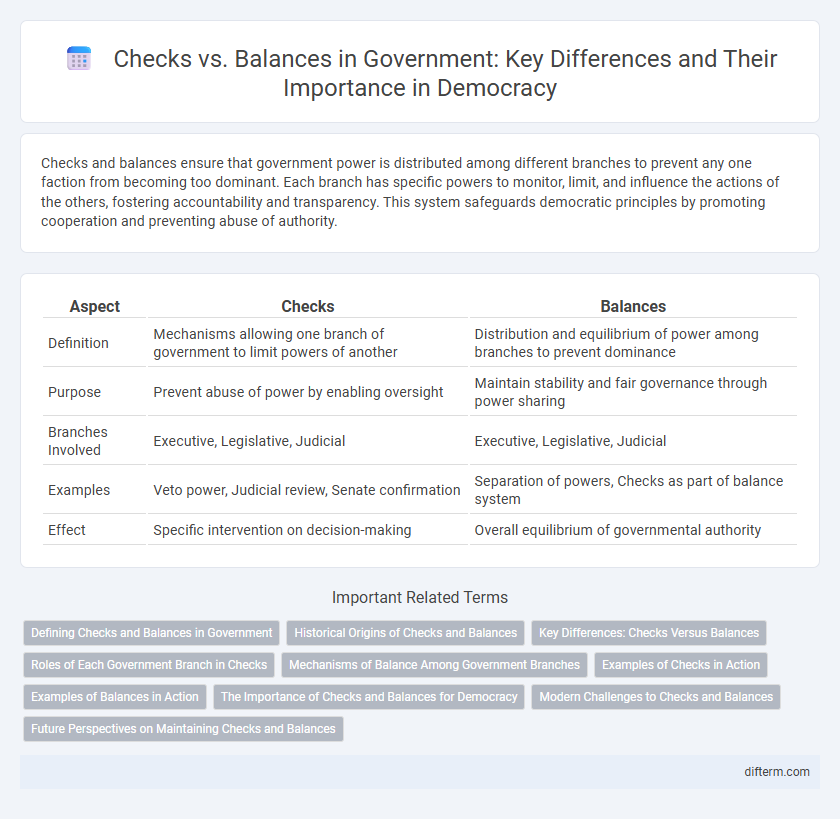Checks and balances ensure that government power is distributed among different branches to prevent any one faction from becoming too dominant. Each branch has specific powers to monitor, limit, and influence the actions of the others, fostering accountability and transparency. This system safeguards democratic principles by promoting cooperation and preventing abuse of authority.
Table of Comparison
| Aspect | Checks | Balances |
|---|---|---|
| Definition | Mechanisms allowing one branch of government to limit powers of another | Distribution and equilibrium of power among branches to prevent dominance |
| Purpose | Prevent abuse of power by enabling oversight | Maintain stability and fair governance through power sharing |
| Branches Involved | Executive, Legislative, Judicial | Executive, Legislative, Judicial |
| Examples | Veto power, Judicial review, Senate confirmation | Separation of powers, Checks as part of balance system |
| Effect | Specific intervention on decision-making | Overall equilibrium of governmental authority |
Defining Checks and Balances in Government
Checks and balances in government refer to the system designed to prevent any one branch from gaining excessive power by enabling each branch to monitor and limit the functions of the others. This framework promotes accountability and separation of powers among the legislative, executive, and judicial branches. By ensuring no single entity dominates, checks and balances maintain the rule of law and uphold democratic governance.
Historical Origins of Checks and Balances
The historical origins of checks and balances trace back to Ancient Greek philosopher Aristotle, who first theorized the separation of powers to prevent tyranny. The concept was further developed during the Renaissance by political thinkers like Montesquieu, whose work "The Spirit of the Laws" profoundly influenced the United States Constitution. Early American framers implemented checks and balances to ensure no single branch of government--executive, legislative, or judicial--could dominate, establishing a framework for democratic governance.
Key Differences: Checks Versus Balances
Checks refer to specific powers granted to each branch of government to limit the actions of the others, such as the presidential veto or congressional impeachment authority. Balances describe the overall system that ensures no single branch gains dominance, maintaining equilibrium through mutual enforcement and cooperation. The key difference lies in checks being concrete mechanisms, while balances represent the broader structural stability between branches.
Roles of Each Government Branch in Checks
The legislative branch holds the power to create laws and oversees the executive through budget control and impeachment authority, ensuring accountability. The executive branch enforces laws while wielding veto power over legislation and appointing judges, influencing the judicial landscape. The judicial branch interprets laws and can declare legislative acts or executive actions unconstitutional, maintaining the rule of law within the system of checks and balances.
Mechanisms of Balance Among Government Branches
The mechanisms of balance among government branches include the power of veto held by the executive branch, judicial review exercised by the judiciary, and legislative oversight conducted by the legislature. These tools ensure no single branch exceeds its constitutional authority, maintaining equilibrium through mutual regulation. Systematic interbranch communication and impeachment powers further reinforce accountability and prevent abuses of power.
Examples of Checks in Action
The president can veto legislation passed by Congress, serving as a direct check on legislative power. The Senate confirms or rejects presidential appointments, ensuring executive accountability. Courts have the authority to declare laws unconstitutional, providing a judicial check on both the legislative and executive branches.
Examples of Balances in Action
The legislative branch can override a presidential veto with a two-thirds majority vote in both houses of Congress, demonstrating a balance of power. The Supreme Court exercises judicial review by declaring laws unconstitutional, ensuring the judiciary limits legislative and executive actions. Presidential appointments require Senate confirmation, providing a check on executive authority through legislative oversight.
The Importance of Checks and Balances for Democracy
Checks and balances are crucial for democracy as they ensure no single branch of government becomes too powerful, preserving individual freedoms and preventing tyranny. This system promotes accountability by enabling legislative, executive, and judicial branches to oversee and limit each other's actions. Effective checks and balances maintain the equilibrium necessary for a functioning, fair, and transparent government.
Modern Challenges to Checks and Balances
Modern challenges to checks and balances include the increasing use of executive orders, which can bypass legislative scrutiny and concentrate power in the executive branch. Polarization within government institutions often weakens oversight mechanisms, reducing the effectiveness of congressional and judicial checks on executive actions. Digital surveillance and misinformation campaigns further complicate these dynamics by influencing public opinion and eroding transparent accountability.
Future Perspectives on Maintaining Checks and Balances
Future perspectives on maintaining checks and balances emphasize the integration of advanced technology in governmental oversight to ensure transparency and accountability. Strengthening institutional independence through reforms that limit executive overreach remains crucial for preserving democratic stability. Embracing digital platforms for citizen engagement can enhance participatory governance and reinforce the system of checks and balances.
Checks vs Balances Infographic

 difterm.com
difterm.com